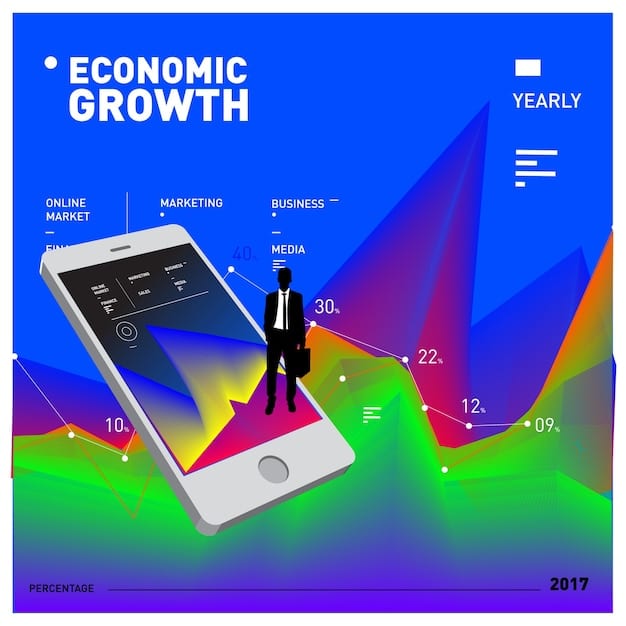Augmented Reality Glasses in 2025: US Adoption Review

Augmented Reality (AR) glasses are undergoing rapid development, yet their mainstream adoption in the US by 2025 hinges on overcoming technological challenges, addressing privacy concerns, and demonstrating clear value to consumers.
Are augmented reality glasses ready for mainstream adoption in the US? A 2025 review reveals a landscape brimming with potential, but also significant hurdles to overcome.
Understanding Augmented Reality Glasses Technology
Augmented reality glasses are more than just futuristic eyewear; they’re a gateway to a new era of computing. But what exactly do they do, and how do they work?
The Core Components
AR glasses function by overlaying digital information onto the user’s real-world view. This is achieved through a combination of sophisticated hardware and software.
Key components include displays (often using micro-OLED or waveguide technology), sensors (cameras, depth sensors, accelerometers), and processing units capable of handling complex computations in real-time.
How AR Overlays Work
The glasses use their sensors to understand the user’s environment. This information is then used to accurately place digital overlays onto the real world. For example, directions might appear superimposed on the street ahead, or product information might pop up when looking at a shelf in a store.
- Display technology: Projects images onto the lenses, making them appear as if they are part of the real world.
- Sensors and cameras: Capture data about the environment and the user’s movements, allowing for accurate tracking and overlay placement.
- Processing power: Handles the complex computations needed to analyze sensor data and render the augmented reality experience.
The evolution of these technologies is critical for making AR glasses smaller, lighter, more power-efficient, and more capable.
Current State of the AR Glasses Market in the US
The AR glasses market in the US is still in its nascent stages, but it’s showing signs of rapid growth. Several companies are vying for a piece of this emerging market.

Key Players and Their Offerings
Tech giants like Apple, Google, and Microsoft are investing heavily in AR technology, alongside smaller startups focused on niche applications. Each company is taking a different approach to the technology and target market.
Some are focusing on enterprise applications, while others are targeting consumers with entertainment and productivity features.
Consumer vs. Enterprise Adoption
Currently, enterprise adoption is leading the way, with AR glasses being used in manufacturing, logistics, healthcare, and training. These applications demonstrate clear ROI and address specific business needs.
- Enterprise: Focuses on increasing efficiency and productivity in various industries.
- Consumer: Aims to enhance entertainment, communication, and everyday tasks.
- Early adopters: Tech enthusiasts and professionals who are willing to experiment with new technologies.
The gap between enterprise and consumer adoption is expected to narrow as the technology matures and becomes more affordable and user-friendly.
Technological Hurdles to Mainstream Adoption
Despite the excitement surrounding AR glasses, several technological challenges need to be addressed before they can achieve mainstream adoption.
Battery Life Limitations
One of the biggest challenges is battery life. Current AR glasses consume a significant amount of power, leading to short usage times. This limits their practicality for everyday use.
Display Quality and Field of View
The quality of the displays and the field of view are also crucial factors. Users want crisp, clear images that seamlessly blend with the real world. A narrow field of view can create a tunnel-like experience, reducing immersion.
Form Factor and Comfort
Bulky and uncomfortable designs are a major barrier to adoption. AR glasses need to be lightweight, stylish, and comfortable to wear for extended periods.
- Power efficiency: Developing more energy-efficient components and optimizing software to reduce power consumption.
- Advanced display technology: Improving resolution, brightness, contrast, and field of view.
- Ergonomics and design: Creating lightweight, comfortable, and aesthetically pleasing designs.
Overcoming these technological hurdles is essential for creating AR glasses that are appealing and practical for a wide range of users.
Addressing Privacy Concerns
Privacy is a major concern surrounding AR glasses, as they have the potential to collect and analyze vast amounts of data about the user and their environment.

Data Collection and Usage
AR glasses can collect data about the user’s location, activities, and interactions. This data can be used to personalize the user experience, but it could also be used for tracking, surveillance, or targeted advertising.
Facial Recognition and Surveillance
Facial recognition technology raises concerns about privacy and surveillance. AR glasses could be used to identify people without their knowledge or consent, potentially leading to discrimination or harassment.
Security Measures and Regulations
Robust security measures are needed to protect user data from unauthorized access and misuse. Clear regulations are also needed to govern the collection, storage, and use of data by AR glasses.
- Transparency: Being upfront with users about what data is being collected and how it is being used.
- User control: Giving users control over their data and the ability to opt out of data collection.
- Security: Implementing robust security measures to protect user data from unauthorized access.
Addressing these privacy concerns is crucial for building trust and fostering widespread adoption of AR glasses.
Potential Applications and Use Cases in 2025
By 2025, AR glasses are expected to find applications in a wide range of areas, transforming how we work, learn, communicate, and entertain ourselves.
Enhanced Productivity and Collaboration
In the workplace, AR glasses can be used to enhance productivity and collaboration. They can provide workers with real-time information, instructions, and assistance, improving efficiency and reducing errors.
Immersive Entertainment and Gaming
AR glasses can create immersive entertainment and gaming experiences. They can overlay digital content onto the real world, blurring the lines between the physical and virtual realms.
Education and Training
AR glasses can be used to enhance education and training. They can provide students with interactive learning experiences, allowing them to visualize complex concepts and practice real-world skills in a safe and controlled environment.
- Remote assistance: Experts can remotely guide technicians through complex repairs, reducing downtime and improving efficiency.
- Interactive learning: Students can explore historical sites, dissect virtual organisms, or practice surgical procedures.
- Personalized entertainment: Users can create their own augmented reality experiences, blending digital content with their physical surroundings.
The potential applications of AR glasses are vast and continue to evolve as the technology advances.
The Path to Mainstream Adoption in the US: A Forecast for 2025
Whether AR glasses achieve mainstream adoption in the US by 2025 depends on a combination of factors, including technological advancements, addressing privacy concerns, and demonstrating clear value to consumers.
Price Point and Affordability
The price point is a major barrier to adoption. AR glasses need to become more affordable to reach a wider audience. As technology scales, the prices hopefully will come down.
User Experience and Ease of Use
The user experience needs to be seamless and intuitive. AR glasses should be easy to set up, use, and maintain. It needs to be an improvement from what older generations have experienced.
Demonstrating Clear Value and Benefits
Consumers need to see clear value and benefits in using AR glasses. They need to understand how the technology can improve their lives.
- Reduced cost: Economies of scale and increased competition can drive down prices.
- Intuitive interfaces: Voice control, hand gestures, and eye tracking can make AR glasses easier to use.
- Compelling applications: A wider range of applications that address everyday needs and desires can drive adoption.
If these challenges can be overcome, AR glasses have the potential to become a mainstream technology in the US by 2025.
| Key Aspect | Brief Description |
|---|---|
| 👓 Technology | AR glasses overlay digital info on the real world using displays and sensors. |
| 💰 Affordability | Price point is a major barrier; mainstream adoption needs lower costs. |
| 🛡️ Privacy | Data collection raises concerns; transparency and security are essential. |
| 💡 Use Cases | Productivity, gaming, and education are potential application areas. |
Frequently Asked Questions
▼
Augmented reality glasses overlay digital information onto the real world, enhancing your perception with computer-generated visuals and data. These glasses use sensors, displays, and processing power to blend digital content seamlessly into your environment.
▼
Key challenges include limited battery life, display quality, comfort, privacy concerns, and high cost. Overcoming these hurdles is crucial for making AR glasses appealing and practical for everyday use in the US market.
▼
In enterprise settings, AR glasses are enhancing productivity, training, and remote assistance. Workers use them for real-time instructions, data visualization, and collaboration, leading to increased efficiency and reduced errors in various industries.
▼
Privacy risks include excessive data collection, potential for facial recognition abuse, and surveillance concerns. Robust security measures and clear regulations are necessary to protect user data and build trust in AR technology.
▼
Enhanced productivity tools, immersive gaming experiences, and educational applications are expected to drive AR glasses adoption in the US by 2025. As the technology improves, more use cases will emerge, making them appealing to a wider audience.
Conclusion
In conclusion, while augmented reality glasses hold immense promise and potential, significant obstacles remain. Addressing technological limitations, privacy concerns, and cost issues will be paramount to achieving widespread adoption in the US by 2025. With continuous innovation and consumer-centric design, AR glasses could revolutionize how we interact with the world around us.

![Quantum Computing for Beginners: A US Geek's Guide [2025] Quantum Computing for Beginners: A US Geek's Guide [2025] - Cover Image](https://dorama2you.com/wp-content/uploads/2025/06/dorama2you.com_3_1749769492_79bdbcc1_cover-360x180.jpg)



